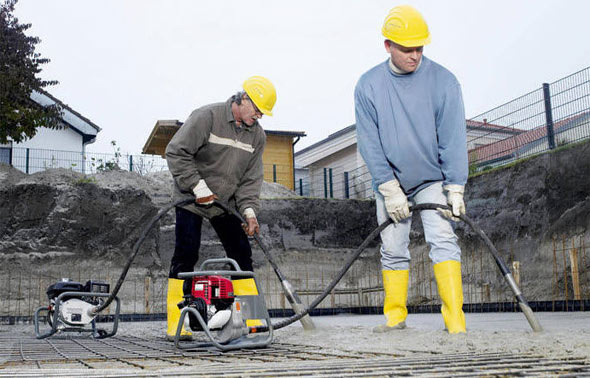Types of concrete vibrators and their benefits
- Concrete Cost Estimator
- Concrete Continuous Footing
- Landscape Bidding and Estimating
- Construction Cost Estimating
- Concrete and steel cost estimation
- Construction Cost Estimate Breakdown
- Construction Estimating Worksheet
- Home Construction Cost Estimate
- Estimate Pricing Sheet
- Sheet for General Contractor
- Construction Cost Estimate
- Labor Materials Cost Estimator
- Masonry Estimating Sheet
- Sheet for Building Contractor
- Construction Schedule Bar chart
- General Cost Estimator Sheet
- General Construction Estimate
- Building and Road Estimating Sheet
- Detailed expense estimates
- Door and Window Takeoff Sheet
- General Construction Cost Estimating Sheet

Vibration of concrete is necessary for consolidation. The purpose of vibration is to condense the concrete and to attain the highest possible density of concrete. By volume, nearly 5 to 8% of freshly placed concrete in the form is captured by air bubbles. Air bubbles take up this space in a high workable concrete mix.
To get rid of air bubbles, the amount of required water should be reduced, but due to this the workability of concrete is significantly influenced. So, vibration of concrete is the only measure to remove air bubbles devoid of changing the properties of fresh concrete. Vibration is only influenced in a fresh mix concrete or one can say up to that time, when concrete contains the strength to flow. This stage prevails prior to start of preliminary setting.
Vibration decreases the internal friction by shuffling the concrete. It facilitates the concrete to reorganize the particles containing coarse aggregates and fine aggregates. After the particles are reorganized than a close configuration of coarse aggregate is attained. Close packing removes most of the clogged air in between, but still some air bubbles are departed. It is complicated to eliminate 100% air bubbles from concrete.
Throughout the vibration of concrete, site engineer should check properly that vibration is employed to the full mass of concrete equally in order that all volume of concrete is full compacted and no portions remain un-compacted.
Site engineer should carefully monitor the vibration time period as over vibration of concrete leads to segregation and bleeding of concrete. So, accurate consistency is essential throughout the vibration.
The following types of concrete vibrators are mainly used :-
1. Internal vibrators 2. External vibrators 3. Vibrating tables
Internal vibrators: They are also known as immersion, poker or needle vibrators. They comprise of a power unit and a long flexible tube at the end of which a vibrating head is connected. Power is supplied by electric motor, compressed air or petrol engine. The long tube arranges a flexible shaft that rotates an eccentric weight inside the vibrating head. The frequency of the vibrator is roughly 700 cycles per minute.
The vibrating head is implanted in the concrete. They are most suitable as the vibrating head touches with concrete.
External vibrators: These vibrators are fastened tightly to the form work at the pre-determined points in order that the form and concrete are vibrated. They use more power for a specified compaction effect as compared to internal vibrators.
These vibrators have the ability to compact up to 450mm from the face but should be shifted from one place to another as concreting is going on. These vibrators run at a frequency of 3000 to 9000 rpm at a speed of 4g.
The external vibrators are mostly utilized for pre-casting of thin in-situ sections of such shape and thickness which cannot be compacted with internal vibrators.
Vibrating tables: These are firmly constructed steel platforms fixed on steel springs and operated by electric motors. The concrete is arranged in moulds fixed on the platforms and firmly fastened to the vibrating table, in order that mould and concrete vibrate in union.
Vibrating tables are useful for compacting inflexible and rough mixes applied in precast structural members in factories and laboratory specimens.

- Application of concrete calculator
- Roofing Calculator can streamline the roof estimating process
- House construction cost calculator
- Engineering column design excel spreadsheet
- Material Estimating Sheet with Excel
- Materials List and Cost Estimate Worksheet
- Concrete Slab Estimating Calculator Sheet
- Common types of foundations for buildings
- Online calculation of construction materials
- Estimating with Excel for the Small Contractor
- Concrete Beam Design Spreadsheet
- Virtual Construction Management app for construction
- Autodesk’s Project Skyscraper
- Reed Construction’s Reed Insight
- Manage your construction project documentation
- Costimator, the popular cost estimating software
- On Center Software for construction professionals
- Free Construction Estimating Software
- Plumbing Calc Pro
- Cost Estimate Worksheet
- HVAC Piping Quantity Takeoff Worksheet
- Construction Estimating Software Sheet
- Estimate Cost Templates
- Construction Punch List
- Construction cost estimating template consisting estimating basic
- Gantt Chart Template for Excel
- Download Civil Engineering Spreadsheets with Verification
- The Building Advisor Estimating and Budgeting Worksheet
- Spreadsheet for design of concrete bridge
- Construction Estimating Software Free








